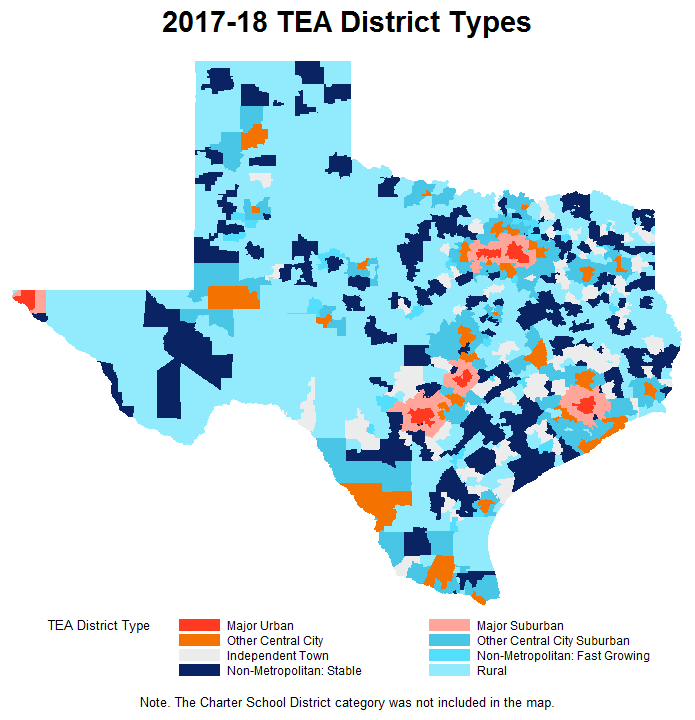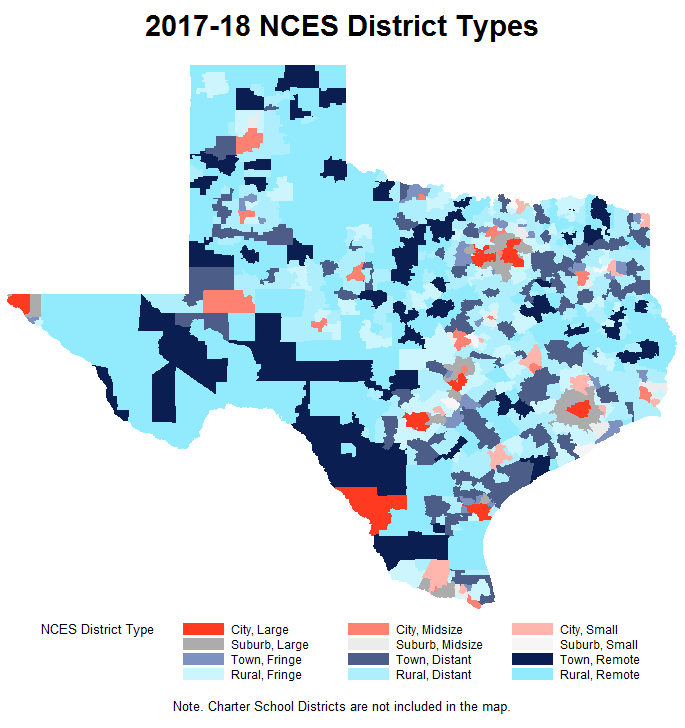District Type, 2017-18
Overview
TEA District Types
TEA classifies Texas public school districts into community types using factors such as enrollment, growth in enrollment, economic status, and proximity to urban areas. These community types, or "district types," group districts into eight categories ranging from major urban to rural. Charter school districts make up a ninth category. TEA uses district type classifications in reporting and monitoring systems. For more information on the 2017-18 district type category descriptions, see the glossary.

NCES District Types
The National Center for Education Statistics (NCES) classifies districts using factors such as population size and proximity to urbanized areas. The NCES places districts into 12 categories, also known as locale classifications or locale codes. The NCES locale framework is composed of four basic types (City, Suburban, Town, and Rural). Each type comprises three subtypes. The subtypes are differentiated by size (in the case of City and Suburban assignments) and proximity (in the case of Town and Rural assignments). Within the NCES system, charter school districts are assigned one of the twelve categories; there is not a separate category for charter school districts. For more information on the 2017-18 NCES district type category descriptions, see the glossary.

Data Downloads
2017-18 District Type Data
The Excel (.xlsx) file below includes Texas public school districts categorized by TEA and NCES district types. The file includes three worksheets that can be accessed using the tabs at the bottom of the workbook. In addition to the dataset, the workbook also provides an overview of the data as well as a data dictionary that defines the variable names in the dataset. To download the file, please click the following link:
Texas public school districts categorized by TEA and NCES district types
House Bill 3 Teacher Incentive Allotment Qualification Information
In 2019, the 86th Texas Legislature passed House Bill 3, which included a teacher incentive allotment. Per Texas Education Code Section 48.112, campuses can qualify for the teacher incentive allotment if they meet the "rural campus" classification of being: (1) located in: (A) an area that is not designated as an urbanized area or an urban cluster by the United States Census Bureau; and (B) a school district with fewer than 5,000 enrolled students; or (2) designated as a rural campus under rules adopted by the commissioner. The information in this workbook is preliminary; commissioner rules for rural designations and decisions on campus designations for allotment funding have yet to be finalized. This workbook will be updated and re-posted once final decisions on campus designations have been finalized. The Excel (.xlsx) file below includes information on which districts (and their campuses) meet either of the rural campus classification criteria. The file includes three worksheets that can be accessed using the tabs at the bottom of the workbook. In addition to the dataset, the workbook also provides an overview of the data as well as a data dictionary that defines the variable names in the dataset. To download the file, please click the following link:
House Bill 3 Teacher Incentive Allotment Qualification Information
Contact Information
For questions or comments, please e‑mail the Division of Research and Analysis, or contact the division by phone at 512-475-3523.
This page last updated October 2019

